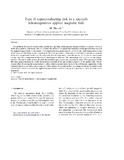Type II superconducting disk in a spatially inhomogeneous applied magnetic field
Date
2003-01Author
Masale, M.
Publisher
Elsevier Science Ltd. www.elsevier.com/locate/physcType
ArticleMetadata
Show full item recordAbstract
The problem of a type II superconducting disk in a spatially inhomogeneous magnetic field is considered. The aim
of the investigations undertaken here is to evaluate the effects of the spatial inhomogeneity of the parallel component of
the applied magnetic field on the nature of the superconducting nucleation of a short cylinder. Full numerical solutions
of the linearized Ginzburg-Landau equation for the order parameter, taking into account only the parallel component
of the field, are presented in the case of a solid disk;free-standing and in a metallic matrix. In the case of a mesoscopic
system, only the limiting form of the critical temperature is obtained. The temperature-field (e-f) curves are characterized
by flux-entry points at each of which the azimuthal quantum number decreases by unity. The quasi-period of the
flux-entry points increases in f with the increasing strength of the spatial inhomogeneity of the applied field. The increased
effect of coating the superconductor with a suitable normal metal leads to the well known suppression of the
critical temperature as well as smoothing out of flux entries. It is predicted that the wiping out of surface nucleation is
effected with relative ease when the applied magnetic field is uniform than when it posseses a degree of spatial inhomogeneity.

